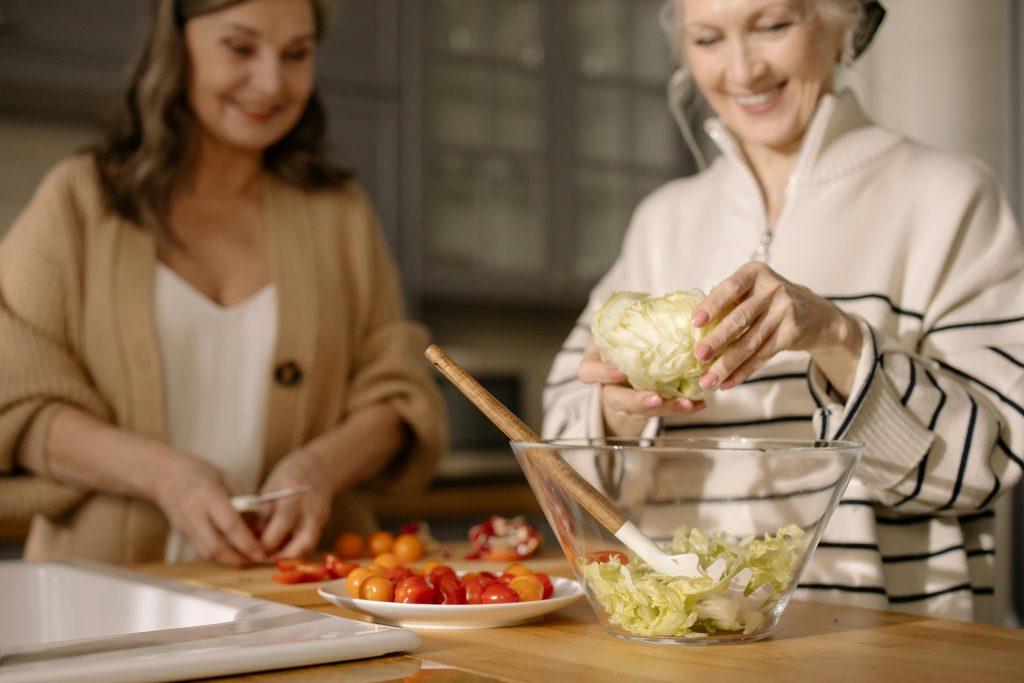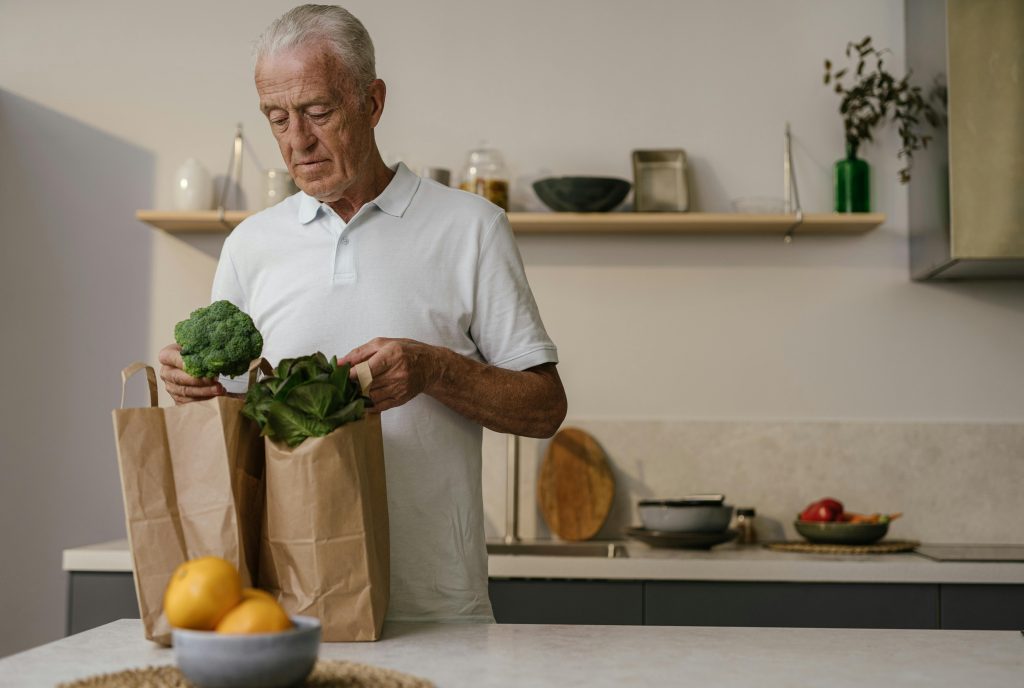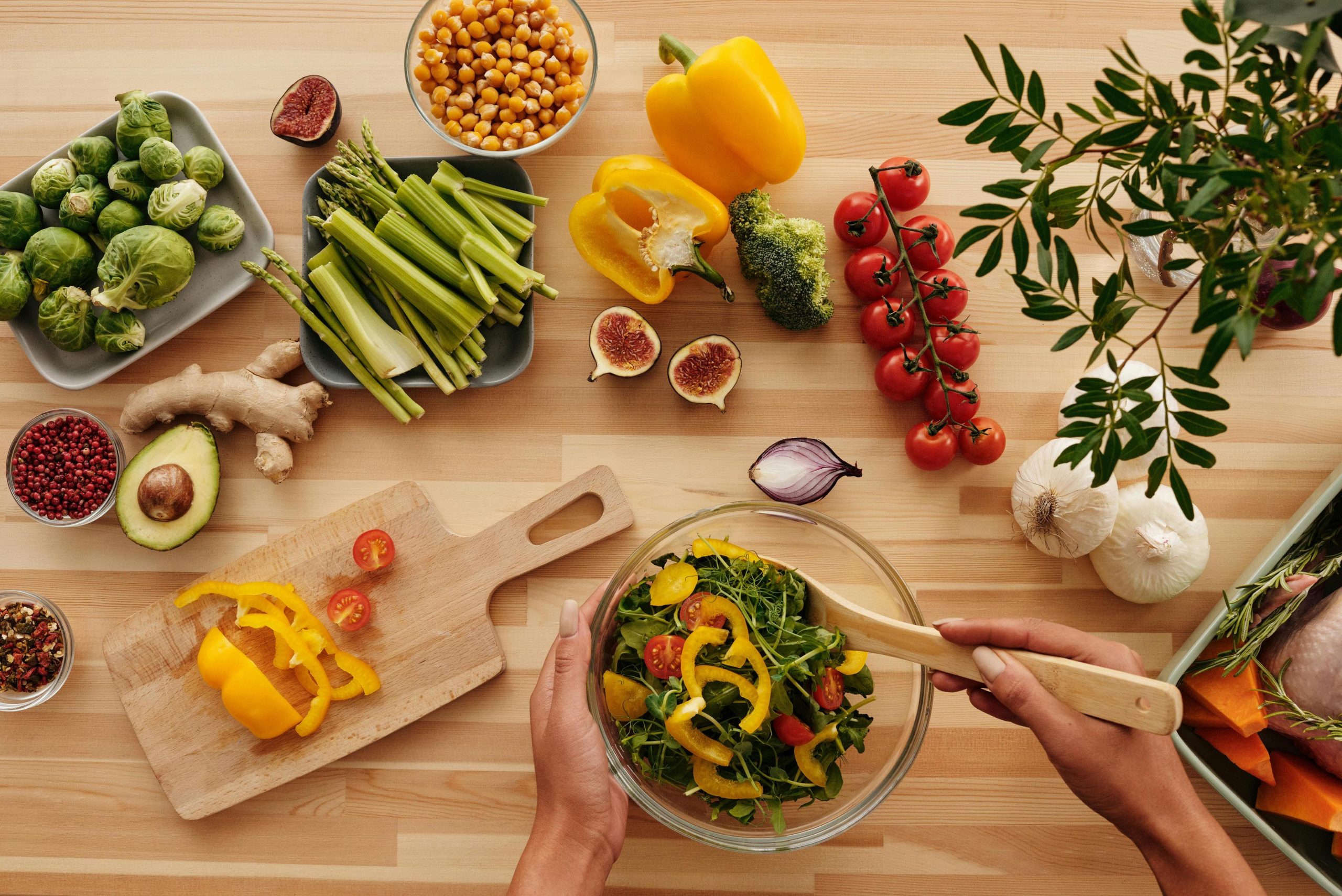Healthy cooking is an essential part of maintaining a senior-friendly lifestyle. Nutrition plays a major role in overall health and well-being, and adapting our diets and cooking methods can help us stay active and healthy as we age. With the right approach, seniors can continue enjoying nutritious meals that support their changing needs.
The Senior Lifestyle

Maintaining an active and fulfilling lifestyle in later years is about more than just physical activity—it also requires a strong focus on overall well-being. Seniors today are more health-conscious than previous generations, recognising the importance of a balanced diet alongside regular exercise. A nutritious diet helps sustain energy levels, supports immune function, and promotes longevity, making it an essential part of ageing well. By making mindful choices about food and nutrition, seniors can continue to enjoy their favourite activities while reducing the risk of age-related health issues.
Advancements in healthcare and a growing awareness of natural remedies mean many seniors are taking a proactive approach to their health. Whether through dietary supplements, alternative therapies, or simply prioritising fresh, wholesome ingredients, older adults are seeking ways to enhance their quality of life. Cooking at home with nutrient-dense foods ensures meals are both nourishing and suited to changing dietary needs, such as maintaining bone density, preserving muscle mass, and supporting digestion.
Healthy eating doesn’t mean sacrificing flavour or enjoyment. Seniors can explore new recipes, experiment with different cooking techniques, and incorporate a variety of colourful fruits and vegetables to create delicious, well-balanced meals. Adapting traditional dishes to be lower in salt, sugar, or unhealthy fats can make a big difference without compromising taste. By embracing healthy cooking as part of their lifestyle, seniors can continue to thrive, stay socially engaged, and make the most of their golden years.
Changes in Nutritional Needs
As we age, the body’s ability to absorb key nutrients such as calcium, vitamin B12, and iron can decline, increasing the risk of deficiencies that may affect bone health, energy levels, and overall well-being. This makes it essential for seniors to choose foods that are naturally rich in these nutrients or opt for fortified options when necessary. For example, dairy products, leafy greens, and lean meats can help maintain bone strength and prevent muscle loss, while whole grains and fibre-rich foods support digestion and heart health.
Hydration is another key factor in maintaining good health, as the sensation of thirst often decreases with age. Seniors should make a conscious effort to drink enough fluids throughout the day, including water, herbal teas, and low-sugar beverages, to prevent dehydration and support digestion. Additionally, incorporating healthy fats from sources like nuts, seeds, and fish can provide essential omega-3 fatty acids, which promote brain function and reduce inflammation.
A well-balanced diet tailored to changing nutritional needs allows seniors to maintain their independence and quality of life. Simple adjustments, such as reducing processed foods, opting for smaller but more frequent meals, and prioritising fresh ingredients, can make a significant difference. By focusing on nutrient-rich foods and maintaining a healthy eating routine, seniors can continue to enjoy an active and fulfilling lifestyle while reducing the risk of diet-related health concerns.
A New Diet for an Ageing Body

Adapting to these dietary changes doesn’t mean sacrificing flavour or variety; rather, it’s about making smarter food choices that align with an ageing body’s needs. Incorporating protein-rich foods such as eggs, tofu, fish, and beans into meals helps maintain muscle strength and energy levels. Seniors may also benefit from consuming smaller, nutrient-dense meals throughout the day to aid digestion and maximise nutrient absorption. Additionally, fermented foods like yoghurt and kimchi can promote gut health, which plays a crucial role in overall well-being.
Since bone density tends to decrease with age, prioritising calcium and vitamin D intake is essential for reducing the risk of osteoporosis and fractures. Dairy products, fortified plant-based alternatives, and leafy greens provide excellent sources of calcium, while spending time in natural sunlight or consuming vitamin D-rich foods like salmon and eggs can further support bone health. Pairing iron-rich foods with sources of vitamin C, such as citrus fruits and capsicums, can also enhance iron absorption, preventing anaemia and maintaining energy levels.
Adjusting to an ageing body’s nutritional needs is about balance and making informed choices. By focusing on whole foods, reducing highly processed options, and ensuring meals are rich in essential nutrients, seniors can continue to lead active, fulfilling lives. Cooking methods such as steaming, baking, and grilling help preserve nutrients while keeping meals light and easy to digest. With a few mindful adjustments, healthy eating can remain enjoyable and rewarding at any stage of life.
The Real Challenge
One of the biggest challenges in adjusting to a healthier diet is maintaining a balance between nutrition and enjoyment. While it’s important to reduce empty calories, meals should still be satisfying and flavourful. Using herbs and spices instead of excessive salt, opting for whole grains over refined carbohydrates, and incorporating a variety of colourful fruits and vegetables can enhance both the taste and nutritional value of meals. These simple adjustments ensure that seniors continue to enjoy their favourite dishes while meeting their evolving dietary needs.
Another key aspect of overcoming this challenge is focusing on portion control and mindful eating. As metabolism slows down, eating smaller, nutrient-dense meals throughout the day can help maintain energy levels without overloading the digestive system. Preparing meals in advance and having healthy snacks readily available can prevent reliance on processed foods, which often lack essential nutrients. Cooking at home also allows for better control over ingredients, reducing the intake of unhealthy additives and preservatives commonly found in pre-packaged meals.
Rather than making drastic dietary changes all at once, gradual adjustments create sustainable habits that last. Swapping out one or two ingredients at a time, such as replacing white rice with quinoa or using olive oil instead of butter, can make a significant impact over time. Encouraging social meal preparation, such as cooking with friends or family, can also make the transition more enjoyable. By focusing on both nutrition and enjoyment, seniors can develop a diet that supports their health without feeling restrictive or overwhelming.
Creating a Senior-Friendly Kitchen
A well-designed kitchen plays a crucial role in promoting healthy eating, especially for seniors who want to maintain their independence. An organised and accessible space makes meal preparation easier, reducing the temptation to opt for processed or convenience foods. Simple upgrades such as pull-out shelves, non-slip flooring, and easy-grip utensils can enhance both safety and efficiency, ensuring that cooking remains an enjoyable part of daily life.
Good lighting, clear workspaces, and functional appliances also contribute to a more user-friendly kitchen. Small changes, like replacing a difficult-to-use stove with one that has front-facing controls or installing a hands-free tap, can make a significant difference. Investing in quality kitchen tools, such as sharp knives and lightweight cookware, can help reduce strain and make cooking less of a chore. These improvements not only support healthy meal preparation but also encourage seniors to continue cooking at home.
Having a well-stocked pantry with nutritious staples is another key aspect of a senior-friendly kitchen. Keeping whole grains, legumes, lean proteins, and a variety of fresh or frozen vegetables on hand makes it easier to prepare balanced meals. By creating a comfortable and functional cooking space, seniors are more likely to maintain healthy eating habits, ultimately supporting their overall well-being.
Stocking Up on Nutrient-Dense Foods
A well-stocked pantry and fridge make healthy cooking easier. Essential items for seniors include:
- Protein sources: Beans, lentils, poultry, turkey, fish, and eggs to support muscle maintenance.
- Whole grains: Steel-cut oats, wholemeal bread, and brown rice for sustained energy and digestive health.
- Dairy & calcium-rich foods: Milk, yoghurt, and cheese, preferably fortified with vitamin D. For those who are lactose-intolerant, alternatives like soy milk or almond yoghurt are good options.
- Iron-rich vegetables: Dark leafy greens, such as spinach and kale, along with vitamin C-rich fruits like oranges to aid iron absorption.
- Antioxidant-rich foods: Berries, nuts, and seeds to promote overall health.
- Hydrating beverages: Water, herbal teas, and low-sugar juices to maintain hydration.
Seniors should aim for around 1,800 calories per day, focusing on nutrient-dense foods rather than empty calories. Something as simple as switching from white bread to wholemeal can make a significant difference in overall health.
Two Key Factors for Success
To successfully maintain a healthy diet, two things are essential: meals must be enjoyable, and changes should be introduced gradually. If food doesn’t taste good, it’s unlikely the habit will stick. Likewise, making small adjustments over time is more sustainable than attempting a complete dietary overhaul overnight.
What a Healthy Senior Meal Looks Like
The more colourful a plate, the more nutritious the meal. A balanced plate should include:
- 50% fruits and vegetables for vitamins and fibre
- 25% lean proteins such as chicken, fish, or legumes
- 25% whole grains like brown rice, wholemeal pasta, or quinoa
Many people overestimate portion sizes, making it easy to consume more than necessary. Understanding appropriate serving sizes can help maintain a healthy diet without overeating.
Serving Size Guide
To put portion sizes into perspective:
- Protein: A portion should be about the size of a deck of cards (200–300 calories).
- Bread: One slice should be roughly the size of a smartphone (100 calories).
- Grains: Half a cup is about the size of a computer mouse (100 calories).
- Fruit: A single serving should be about the size of a small tennis ball (100 calories).
- Vegetables: A serving should be about the size of a baseball (30–50 calories).
- Fats & oils: One tablespoon of butter or oil is about the size of the tip of your thumb (100 calories).
Understanding these comparisons can help seniors make informed dietary choices and prevent unintentional overeating.
Reading Nutrition Labels
Now that you have a better understanding of portion sizes, reading nutrition labels becomes even more important. If you struggle to pronounce the ingredients in a product, it’s often best to choose a simpler, less processed alternative.
Processed foods tend to contain high amounts of sodium, preservatives, and additives that aren’t beneficial for long-term health. Fresh, whole foods are always the best option.
Meal Preparation for Convenience
For seniors with busy lifestyles, meal prepping can ensure nutritious meals are always available. Setting aside time to cook in bulk means ready-made meals can be stored in the fridge or freezer, reducing the temptation to opt for unhealthy fast food.
Planning meals in advance not only helps maintain a healthy diet but also saves money. Buying ingredients in bulk and cooking large batches can be more cost-effective than frequent trips to the supermarket.
Improving Cooking Skills
Improving cooking skills can empower seniors to make healthier choices and enjoy a more varied diet. Understanding how to prepare balanced meals using fresh, whole ingredients ensures that essential nutrients are included in daily meals. Whether it’s learning new cooking techniques, adapting recipes for specific dietary needs, or discovering healthier ingredient swaps, expanding culinary knowledge can enhance both nutrition and enjoyment in the kitchen.
Many community centres and organisations offer cooking classes specifically designed for seniors, providing hands-on experience and guidance on meal planning. TAFEs and universities also run short courses focused on nutrition and healthy meal preparation, helping seniors gain confidence in their cooking abilities. Online resources, including instructional videos and recipe websites, make it easier than ever to learn new skills from home.
Participating in cooking classes or workshops also fosters social engagement, which is beneficial for mental well-being. Cooking with others can be an enjoyable and rewarding experience, encouraging seniors to share meals and recipes while maintaining a balanced diet. By continuously improving cooking skills, seniors can take control of their nutrition, making healthy eating a sustainable and enjoyable part of their lifestyle.
Enjoying a Healthy Lifestyle
Good nutrition is the foundation of a long, active life. By making small adjustments to diet and cooking habits, seniors can enjoy their golden years while maintaining optimal health. With the right approach, it’s possible to create meals that are both nourishing and enjoyable—ensuring a vibrant and fulfilling lifestyle well into the future.
